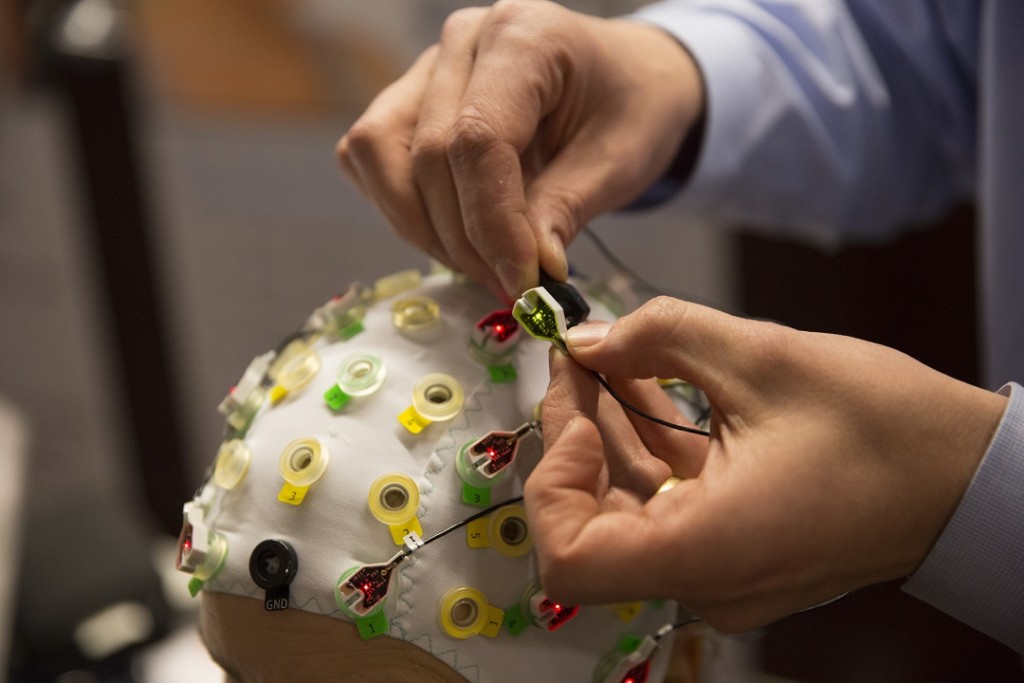The BRAIN Center will develop safe, effective and affordable personalized neurotechnologies for diagnostics, restoration, enhancement, and rehabilitation of sensory, motor, affective and cognitive functions. This mission will be pursued by supporting innovative interdisciplinary research across the multiple dimensions of brain function and behavior with the ultimate goal of improving quality of life.

photo courtesy of Pete Zrioka/ASU
Tempe, AZ, March 2, 2016 – An Industry/University Cooperative Research Center (I/UCRC) Planning Grant has been awarded by the National Science Foundation (NSF) to Arizona State University’s School of Biological and Health Systems Engineering (SBHSE), one of the Ira A. Fulton Schools of Engineering, and the Cullen College of Engineering at the University of Houston.
On Thursday, March 10 and Friday, March 11, the first Planning Grant Meeting of the Building Reliable Advances and Innovation in Neurotechnologies (BRAIN) Center will bring together participating researchers, clinicians and industry collaborators at ASU.
This NSF I/UCRC will focus on neurotechnology and will develop safe, effective and affordable personalized neurotechnologies for the restoration, enhancement and rehabilitation of sensory, motor, affective and cognitive functions.
“Medical advances have brought about a dramatic rise in life expectancy for the 21st century, which has triggered an increase in of chronic and degenerative diseases and accompanying healthcare costs,” explains Marco Santello, Ph.D., Director of SBHSE, who will serve as principal investigator for the ASU site.
“The BRAIN Center’s fully-faceted partnership between universities, clinicians, federal agencies and industry will enable us to develop safe, reliable neurotechnologies that otherwise would not be possible,” emphasized Jose Contreras-Vidal, Ph.D., Hugh Roy and Lillie Cranz Cullen Distinguished Professor of electrical and computer engineering at UH, who will serve as principal investigator of the UH site.
Among the diseases and traumas to be addressed by the BRAIN Center are those that significantly affect mobility, such as stroke, spinal cord injury, and Parkinson’s disease, and illnesses that limit or block sensation, such as retinitis pigmentosa and other forms of blindness. Diseases that directly affect sensory and motor function also often have other, simultaneous effects, including hypertension, epilepsy, depression, cognition and emotion. “Neurotechnologies can reduce those effects,” says Santello.
Industry partners represented in the planning session include: 3Scan, Abbott Nutrition, Barrow Neurological Institute – Dignity Health, Blackrock, Brain Products/Brain Vision, Core Institute, EGI, Ekso Bionics, Eos, FDA – Division of Physical Medicine & Neurological Sciences, General Electric, Houston Methodist Hospital, Indus Instruments, Inhance, Institute for Mobility and Longevity, LivaNova, Lundbeck Pharmaceutical Services, Mayo Clinic, Medtronic, More Foundation, NASA, National Instruments, NIH/National Institute of Neurological Disorders and Stroke, Phoenix Children’s Hospital, Pinnacle Transplant Technologies, Rex Bionics, SolidScape and TIRR Memorial Hermann.
For more information or to register for the event, visit the BRAIN Center site. (https://engineering.asu.edu/brain/)

About Ira A. Fulton Schools of Engineering at Arizona State University
The Ira A Fulton Schools of Engineering, one of 24 independent school units at ASU, is comprised of six engineering schools: the School of Biological and Health Systems Engineering; the School of Computing, Informatics, and Decision Systems Engineering; the School of Electrical, Computer and Energy Engineering; the School for Engineering of Matter, Transport and Energy; the School of Sustainable Engineering and the Built Environment; and The Polytechnic School. Fulton offers 24 undergraduate and 32 graduate programs on its Tempe and Polytechnic campuses and online. Fall, 2015 enrollment in Fulton programs was more than 19,000 students. To meet this growth and expand its research expertise in core areas of health, energy, education, security and sustainability, faculty numbers have grown to more than 320. Research expenditures for fiscal 2015 were an estimated $89.6 million.
About the University of Houston
The University of Houston is a Carnegie-designated Tier One public research university recognized by The Princeton Review as one of the nation’s best colleges for undergraduate education. UH serves the globally competitive Houston and Gulf Coast Region by providing world-class faculty, experiential learning and strategic industry partnerships. Located in the nation’s fourth-largest city, UH serves more than 42,700 students in the most ethnically and culturally diverse region in the country.
# # #
Media Contacts:
Theresa Grant, Communications
Ira A. Fulton Schools of Engineering
Arizona State University
480-727-4089 office
520-907-2248
Jeannie Kever
UH Marketing & Communications
University of Houston
A Carnegie-designated Tier One public research University
713-743-0778 office
713-504-3769 mobile
